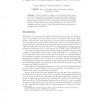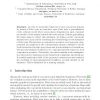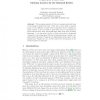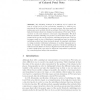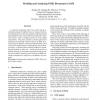80
Voted
EUROMICRO
2000
IEEE
15 years 5 months ago
2000
IEEE
The complexity of embedded systems is increasing rapidly. In consequence, new verification techniques that overcome the limitations of traditional methods and are suitable for har...
85
Voted
FSTTCS
2001
Springer
15 years 5 months ago
2001
Springer
Abstract. In [12] we started a research on a distributed-timed extension of Petri nets where time parameters are associated with tokens and arcs carry constraints that qualify the ...
FOSSACS
2001
Springer
15 years 5 months ago
2001
Springer
Abstract. We study the expressiveness of the join calculus by comparison with (generalised, coloured) Petri nets and using tools from type theory. More precisely, we consider four ...
99
Voted
CONCUR
2001
Springer
15 years 5 months ago
2001
Springer
Abstract. In this paper we discuss the role of labels in transition systems with regard to bisimilarity and model checking problems. We suggest a general reduction from labelled tr...
175
click to vote
CONCUR
2001
Springer
15 years 5 months ago
2001
Springer
In order to model the behaviour of open concurrent systems by means of Petri nets, we introduce open Petri nets, a generalization of the ordinary model where some places, designate...
100
Voted
APN
2001
Springer
15 years 5 months ago
2001
Springer
The increasing number of Petri net variants naturally leads to the question whether the term “Petri net” is more than a common name for very different concepts. This contribut...
89
Voted
SOFSEM
2009
Springer
15 years 5 months ago
2009
Springer
In this paper we define partial order semantics of types of nets. Types of nets are a parametric definition of Petri nets originally developed for a general presentation of the s...
78
Voted
ICALP
2010
Springer
15 years 5 months ago
2010
Springer
We show that the downward-closure of a Petri net language is effectively computable. This is mainly done by using the notions defined for showing decidability of the reachability...
117
Voted
APN
2010
Springer
15 years 5 months ago
2010
Springer
The unfolding technique is an efficient tool to explore the runs of a Petri net in a true concurrency semantics, i.e. without constructing all the interleavings of concurrent actio...
98
Voted
MSE
2002
IEEE
15 years 5 months ago
2002
IEEE
A composite multimedia object has specific timing relationships among the different types of component media. Coordinating the real-time presentation of information and maintaini...

